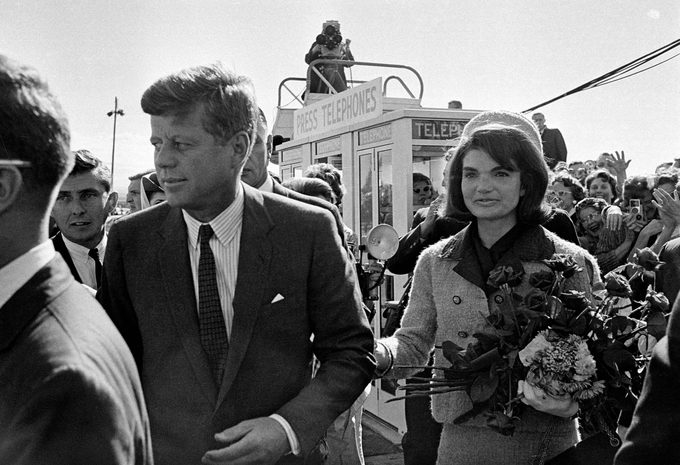Camelot came to an end when President John F. Kennedy was assassinated in 1963. What were JFK's final words? Historians weigh in.

The Truth Behind JFK’s Last Words Before He Died

President John F. Kennedy was assassinated in 1963, and people have been discussing his last words for more than 60 years. JFK’s last words weren’t powerful or poetic, and they weren’t part of a moving speech or a final message to the nation. They were surprisingly light and casual. But knowing that JFK’s last words were spoken seconds before the fatal shot makes them all the more sad and chilling.
At the heart of that moment was a complicated love story—one marked by glamour, heartbreak and a tragic ending that only deepened its legend. Even now, the romance between John and Jackie Kennedy lives on in nostalgic photographs and the quiet power of those final words.
What did he say in his final seconds, before the world changed forever? Keep reading to find out what JFK’s last words really were.
Get Reader’s Digest’s Read Up newsletter for more news, tech, travel, cleaning, humor and fun facts all week long.
What did President Kennedy’s last moments look like?

It started out like any campaign stop: smiles, handshakes and Jackie by his side. But just moments after a casual remark, JFK’s last words were spoken. Here’s how the day took a tragic turn:
Campaign rally
On November 22, 1963, President John F. Kennedy was seated beside his smartly dressed wife, who was wearing a pink Chanel-like suit with a matching pillbox hat and holding an armful of red roses. The flowers had been presented to her by adoring fans. They were seated in the back seat of a dark blue 1961 Lincoln Continental convertible sedan with John Connally, the governor of Texas, and his wife, Nellie. Jack was waving at the crowd that had assembled to watch the presidential motorcade proceed through the streets of Dallas.
The assassination
As the motorcade passed the Texas School Book Depository on Elm Street, a loud noise—like the sound of a firecracker or a car backfiring—cracked the air. Then came utter confusion: President Kennedy slumping forward; Jackie putting her arms around him. Then another loud burst, and another. Jackie abruptly crawled out onto the Lincoln’s trunk. She seemed to be reaching for something.
The aftermath
As recounted in the book These Few Precious Days: The Final Year of Jack with Jackie, by Christopher Anderson, the look on her husband’s face after he was shot would haunt Jackie for the rest of her life. He looked puzzled, as Britain’s the Mirror described it.
The last words she ever got to say to him were, “I love you, Jack. I love you,” according to Anderson. But in a 1963 interview, Jackie herself recalled it slightly differently: All the way to Parkland Hospital, where President Kennedy would eventually be pronounced dead, she was bent over him, asking “Jack, Jack, can you hear me? I love you.”
What were JFK’s last words?
Historians have confirmed that JFK’s last words before the fatal shot were, “No, you certainly can’t.” Without context, this utterance doesn’t make much sense, but it turns out that the president and the governor’s wife were making small talk in the car.
“You certainly can’t say that the people of Dallas haven’t given you a nice welcome,” Nellie Connally had just remarked to the president, referring to the huge, adoring crowd. A split second before the shots rang out, JFK’s last words were an answer to that observation: “No, you certainly can’t.”
It’s often been reported that JFK’s last words were, “My God, I’ve been hit,” but physicians have said this was impossible given his injuries. The president was still alive when he was admitted to the hospital less than 10 minutes later, and Jackie did not leave his side or take off the suit, which was now blood-soaked and splattered with brain tissue.
At the hospital, when Second Lady “Ladybird” Johnson asked Jackie if she wanted to change out of her suit, Jackie refused, saying: “I want them to see what they have done to Jack.”
Why trust us
At Reader’s Digest, we’re committed to producing high-quality content by writers with expertise and experience in their field in consultation with relevant, qualified experts. We rely on reputable primary sources, including government and professional organizations and academic institutions as well as our writers’ personal experiences where appropriate. We verify all facts and data, back them with credible sourcing and revisit them over time to ensure they remain accurate and up to date. Read more about our team, our contributors and our editorial policies.
Sources:
- Christopher Anderson: These Few Precious Days: The Final Year of Jack with Jackie
- Mirror: “As John F Kennedy lay dying Jackie whispered – I love you Jack, I love you”
- PBS: “Selections from Lady Bird’s Diary on the assassination”
- The Week: “The last words and final moments of 40 presidents”
- Seattle Times: “Jackie’s Memories Of JFK’s Death—In 1963 Interview, She Talked Of Seeing Husband Shot”























